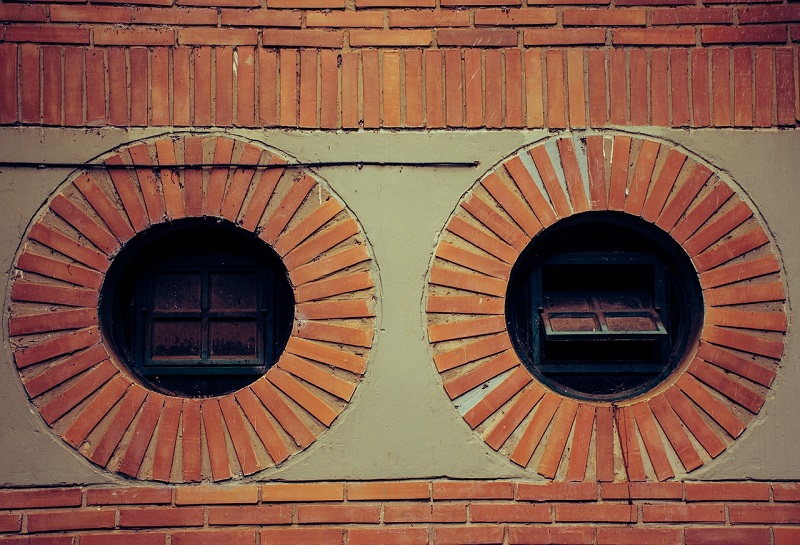Bullseye window

|
| In the bullseye pictured above, standard headers-on-end have been used, resulting in wide joints at the extrados. Using a special tapered brick would have produced parallel mortar joints. |
A bullseye window is a circular opening in a wall (of any material) that features a window. It may be referred to as a ‘bullseye’ (or ‘bullseyes’ (pl.)) and can be found in brickwork, concrete, stone, metal cladding and other walling types.
Achieving a perfect circle can be difficult, the degree of which will depend on the material. In in-situ- poured concrete, the shape will be determined by the accuracy of the formwork. In profiled metal cladding, the circle will have to be cut, sometimes by hand (factory laser-cutting may be easier and more precise).
[edit] Brickwork bullseyes
In brickwork, a bullseye opening can be created by using ‘brick on end’ where the bricks – whether the stretcher or header faces – are laid upright around the opening. Using the stretcher face laid horizontally would normally result in a very unsatisfactory opening aesthetically unless the radii concerned are very large, such as was the case at Louis Kahn’s parliament buildings in Dacca. This is because the short headers (on edge normally) are more able to adapt to the required curvature than the longer stretcher faces which consequently are rarely used for this purpose.
In cavity walls where the brick thickness is 102.5mm, a circular opening can be created by a single- brick circular course; in solid brick walls, particularly when thicker than 215mm, more courses may be used.
[edit] Limitations of the standard brick

|
| The photo above shows widely tapered mortar joints at the extrados which can occur when using standard bricks, in this case, stretchers placed 'on end'. On small radii such as these, tapered bricks may have produced a neater effect. |
Standard bricks may be used for circular openings but if the opening radius is small, the phenomenon of ‘tapering’ of the mortar joints around the circumference occurs. This is where the mortar joint at the top of the brick (extrados) is appreciably wider than that at the inside edge of the opening (intrados). The result can be unsightly, and – if the taper is wide enough at the top end – could result in some bricks at the top of the arch becoming loose.
Aesthetically and structurally, it is considered better for all mortar joints around the opening to have a constant 10mm width so no tapering occurs and all the brick sides are parallel. This can be achieved by using special trapezoidal-shaped bricks where the outer (extrados) edge is wider than the lower (intrados) edge. The downside of this approach is that compared to standard bricks, ‘specials’ can be very expensive.
[edit] Related articles on Designing Buildings Wiki
Featured articles and news
RTPI leader to become new CIOB Chief Executive Officer
Dr Victoria Hills MRTPI, FICE to take over after Caroline Gumble’s departure.
Social and affordable housing, a long term plan for delivery
The “Delivering a Decade of Renewal for Social and Affordable Housing” strategy sets out future path.
A change to adoptive architecture
Effects of global weather warming on architectural detailing, material choice and human interaction.
The proposed publicly owned and backed subsidiary of Homes England, to facilitate new homes.
How big is the problem and what can we do to mitigate the effects?
Overheating guidance and tools for building designers
A number of cool guides to help with the heat.
The UK's Modern Industrial Strategy: A 10 year plan
Previous consultation criticism, current key elements and general support with some persisting reservations.
Building Safety Regulator reforms
New roles, new staff and a new fast track service pave the way for a single construction regulator.
Architectural Technologist CPDs and Communications
CIAT CPD… and how you can do it!
Cooling centres and cool spaces
Managing extreme heat in cities by directing the public to places for heat stress relief and water sources.
Winter gardens: A brief history and warm variations
Extending the season with glass in different forms and terms.
Restoring Great Yarmouth's Winter Gardens
Transforming one of the least sustainable constructions imaginable.
Construction Skills Mission Board launch sector drive
Newly formed government and industry collaboration set strategy for recruiting an additional 100,000 construction workers a year.
New Architects Code comes into effect in September 2025
ARB Architects Code of Conduct and Practice available with ongoing consultation regarding guidance.
Welsh Skills Body (Medr) launches ambitious plan
The new skills body brings together funding and regulation of tertiary education and research for the devolved nation.
Paul Gandy FCIOB announced as next CIOB President
Former Tilbury Douglas CEO takes helm.
UK Infrastructure: A 10 Year Strategy. In brief with reactions
With the National Infrastructure and Service Transformation Authority (NISTA).






















